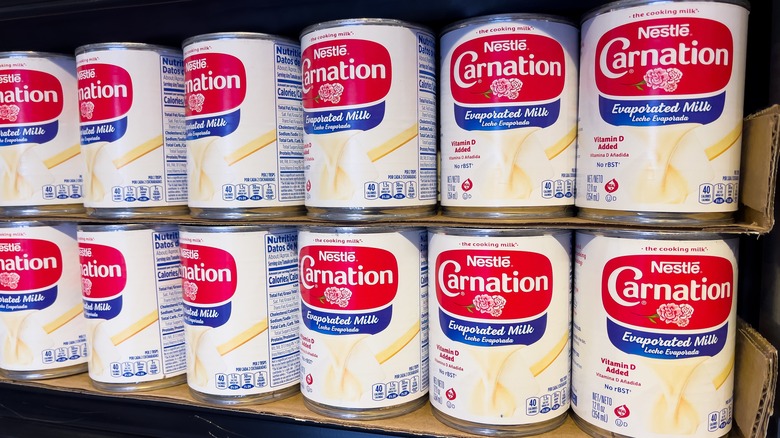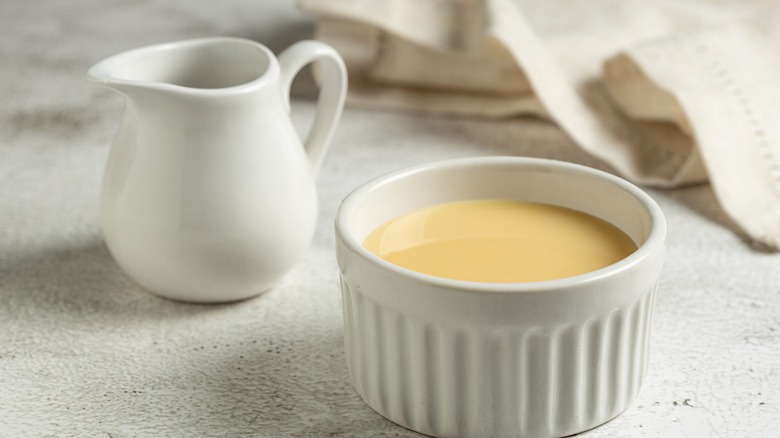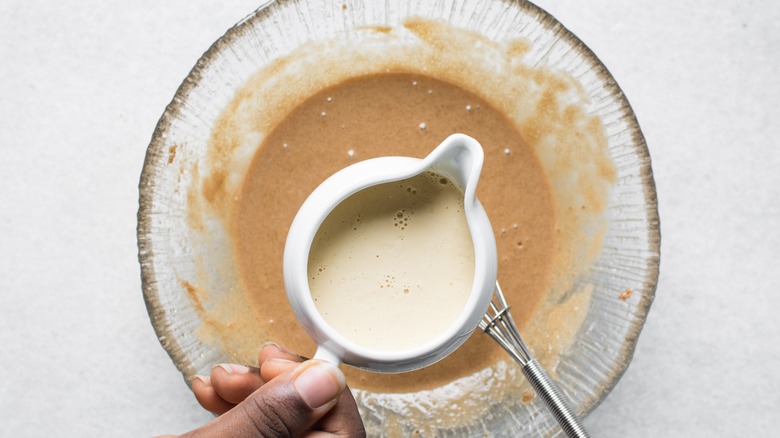The Crucial Step To Using Evaporated Milk As A Substitute For Milk
If you're in the process of preparing a dish and suddenly realize you're missing a crucial ingredient like milk, don't panic just yet because you may have a substitute right in your pantry: Evaporated milk. As the name suggests, evaporated milk is a dairy product just like fresh milk, however, these two aren't identical. To use evaporated milk in place of milk, one crucial step you'll need to take first is adding water.
Since evaporated milk is thicker and creamier than fresh milk, using it as is will result in a slightly thicker or creamier consistency than usual. Now, that's not necessarily a bad thing, but if it's not what you were aiming for, the finished dish may feel a bit off. To avoid this situation, simply dilute the evaporated milk by mixing one part water with one part evaporated milk. For example, if your recipe calls for one cup of fresh milk, the ideal substitute will be a mixture of ½ a cup of water and ½ a cup of evaporated milk.
But why exactly do we dilute evaporated milk when substituting for regular milk? It's all about the composition and how it compares to regular milk.
Evaporated milk versus regular milk
Understanding the composition of an ingredient and how it compares to its substitute will take you one step closer to achieving a successful ingredient swap when the former is missing. It's not just a matter of switching places but ensuring the fill-in ingredient contains the necessary elements for achieving the desired effect in the finished dish. Let's begin with milk. It consists of about 87% water and 13% solids, which include fats, proteins, carbohydrates, and minerals.
On the other hand, evaporated milk consists of about 60% less water than fresh milk. This is because it's made by heating or evaporating fresh milk until part of the water vaporizes, leaving behind a highly concentrated dairy product. The higher percentage of solids (23%) in evaporated milk makes it creamier and slightly sweeter than regular milk even though there's no added sweetener. The color of the milk also becomes slightly darker with a yellowish tinge. Additionally, due to heating, evaporated milk acquires a mildly caramelized flavor though it may not be very apparent in dishes containing several other ingredients besides the milk.
Diluting evaporated milk with equal parts water is what tones down the higher concentration, making it much more similar to regular milk and therefore able to create the expected taste and texture.
When to use evaporated milk in place of milk
Any recipe that calls for milk can be made using evaporated milk in a pinch. Beverages like coffee, hot chocolate, or tea have milk as one of the main ingredients, hence any slight difference in the substitute ingredient will be more noticeable. Therefore, if you want the same taste and consistency, diluting evaporated milk is a must. This also goes for making a bowl of breakfast cereal or even drinking the milk plain.
Baked goods like cookies and cakes can also be made with evaporated milk. If you're after a richer flavor, feel free to use the evaporated milk as is without diluting. However, note that this type of milk may result in a denser bake due to the lower water content. Pancakes and ice cream are other popular treats that can be made using evaporated milk instead of milk.
As a busy home cook, you don't only have to wait until you're in a pinch to use evaporated milk. With its long shelf life of over a year when unopened, you can stock up on this dairy concentrate to avoid frequent grocery store runs whenever you need milk.


